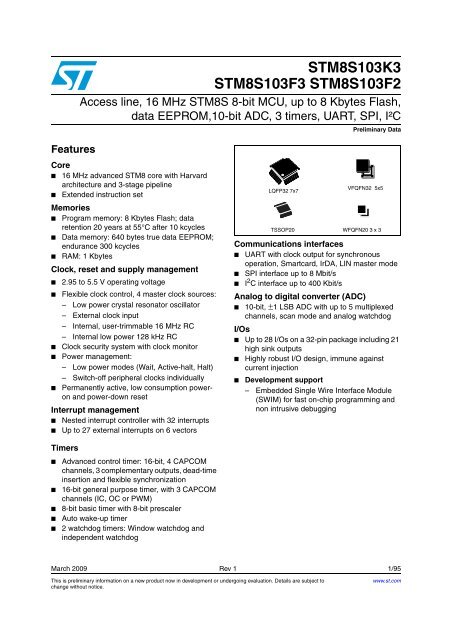
- #Stm8 cosmic simulated stack bug generator
- #Stm8 cosmic simulated stack bug drivers
- #Stm8 cosmic simulated stack bug upgrade
- #Stm8 cosmic simulated stack bug full
- #Stm8 cosmic simulated stack bug license
Preemptive scheduler with 255 priority levels. Atomthreads will always be a small number of C files which are easy to port to any platforms that require threading by adding a simple architecture-specific file. #Stm8 cosmic simulated stack bug drivers
No file system, IP stack or device drivers are included, but developers can bolt on their own as required. It is targeted at systems that need only a scheduler and the usual RTOS primitives.
#Stm8 cosmic simulated stack bug license
It is released under the flexible, open source BSD license and is free to use for commercial or educational purposes without restriction.
1× high-resolution timer (2.Atomthreads is a free, lightweight, portable, real-time scheduler for embedded systems. Chrom-ART graphical hardware Accelerator (DMA2D) to reduce CPU load. LCD-TFT controller up to XGA resolution. 1× digital filters for sigma delta modulator (DFSDM) with 8 channels/4 filters. 2× operational amplifiers (7.3 MHz bandwidth). resolution (up to 36 channels, up to 3.6 MSPS) 8- to 14-bit camera interface (up to 80 MHz). Ethernet MAC interface with DMA controller. 2× USB OTG interfaces (1FS, 1HS/FS) crystal-less solution with LPM and BCD. 2× CAN controllers: 2 with CAN FD, 1 with time-triggered CAN (TT-CAN). 2× SD/SDIO/MMC interfaces (up to 125 MHz). 6× SPIs, 3 with muxed duplex I2S audio class accuracy via internal audio PLL or external clock, 1x I2S in LP domain (up to 150 MHz). 4× USARTs/4x UARTs (ISO7816 interface, LIN, IrDA, up to 12.5 Mbit/s) and 1x LPUART. 1× basic DMA with request router capabilities. 1× high-speed master direct memory access controller (MDMA) with linked list support. 3× PLLs (1 for the system clock, 2 for kernel clocks) with Fractional mode. External oscillators: 4-48 MHz HSE, 32.768 kHz LSE. Internal oscillators: 64 MHz HSI, 48 MHz HSI48, 4 MHz CSI, 32 kHz LSI. 2.95 ♚ in Standby mode (Backup SRAM OFF, RTC/LSE ON). CPU and domain power state monitoring pins. V BAT battery operating mode with charging capability. Low-power modes: Sleep, Stop, Standby and V BAT supporting battery charging. Voltage reference for analog peripheral/V REF+. Voltage scaling in Run and Stop mode (6 configurable ranges). Embedded regulator (LDO) with configurable scalable output to supply the digital circuitry. Dedicated USB power embedding a 3.3 V internal regulator to supply the internal PHYs. 
1.62 to 3.6 V application supply and I/Os.D3: reset/clock control/power management.D2: communication peripherals and timers.3 separate power domains which can be independently clock-gated or switched off:.Up to 168 I/O ports with interrupt capability.
#Stm8 cosmic simulated stack bug upgrade
ROP, PC-ROP, active tamper, secure firmware upgrade support, Secure access mode. SRAM, PSRAM, NOR Flash memory clocked up to 133 MHz in synchronous mode. Flexible external memory controller with up to 32-bit data bus:. Dual mode Quad-SPI memory interface running up to 133 MHz. 64 Kbytes of ITCM RAM + 128 Kbytes of DTCM RAM for time critical routines), 864 Kbytes of user SRAM, and 4 Kbytes of SRAM in Backup domain 1 Mbyte of RAM: 192 Kbytes of TCM RAM (inc. 32-bit Arm ® Cortex ®-M7 core with double-precision FPU and L1 cache: 16 Kbytes of data and 16 Kbytes of instruction cache frequency up to 480 MHz, MPU, 1027 DMIPS/ 2.14 DMIPS/MHz (Dhrystone 2.1), and DSP instructions. They also feature standard and advanced communication interfaces. The devices support four digital filters for external sigma-delta modulators (DFSDM). #Stm8 cosmic simulated stack bug generator
All the devices offer three ADCs, two DACs, two ultra-low power comparators, a low-power RTC, a high-resolution timer, 12 general-purpose 16-bit timers, two PWM timers for motor control, five low-power timers, a true random number generator (RNG), and a cryptographic acceleration cell. STM32H750xB devices incorporate high-speed embedded memories with a Flash memory of 128 Kbytes, up to 1 Mbyte of RAM (including 192 Kbytes of TCM RAM, up to 864 Kbytes of user SRAM and 4 Kbytes of backup SRAM), as well as an extensive range of enhanced I/Os and peripherals connected to APB buses, AHB buses, 2x32-bit multi-AHB bus matrix and a multi layer AXI interconnect supporting internal and external memory access.
#Stm8 cosmic simulated stack bug full
STM32H750xB devices support a full set of DSP instructions and a memory protection unit (MPU) to enhance application security. The Cortex ® -M7 core features a floating point unit (FPU) which supports Arm ® double-precision (IEEE 754 compliant) and single-precision data-processing instructions and data types.

Description STM32H750xB devices are based on the high-performance Arm ® Cortex ®-M7 32-bit RISC core operating at up to 480 MHz.






 0 kommentar(er)
0 kommentar(er)
